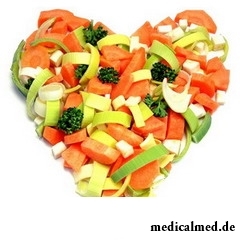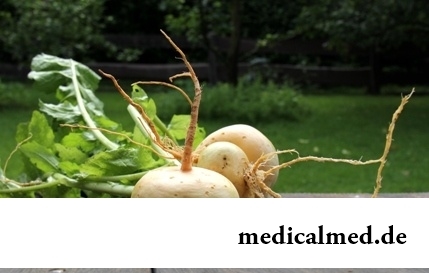





Diets at diseases
 Not only medicamentous therapy, but also balanced clinical nutrition is necessary for successful treatment of the majority of diseases. The medical diets applied at various diseases were developed. The patients adhering to the principles of treatment-and-prophylactic food, as a rule, quicker recover, have less recurrence of chronic diseases.
Not only medicamentous therapy, but also balanced clinical nutrition is necessary for successful treatment of the majority of diseases. The medical diets applied at various diseases were developed. The patients adhering to the principles of treatment-and-prophylactic food, as a rule, quicker recover, have less recurrence of chronic diseases.
In a set of cases the exacerbation of a disease is connected with disturbance of a diet. Can be examples chronic pancreatitis, hypo - or hyper glycemic a coma at a diabetes mellitus, hypertensive crises 2 types at patients with arterial hypertension.
Not only what products you use, but also a way of their culinary processing, frequency rate of meal, etc. is important for balanced and clinical nutrition.
Main objective of the appointed medical diet at a disease is impact on the reason which caused it. It can be even the only option of treatment of a disease. It happens at disturbances in a metabolism, diseases of kidneys, digestive tract diseases. However most often dietary and treatment-and-prophylactic food is combined with other ways of treatment.
In any medical or preventive institution, and also at schools, kindergartens it is possible to meet examples of treatment-and-prophylactic food.
The institute of food of the Russian Academy of Medical Science developed special medical diets. In total them 15. Some diets at diseases can include subgroups since at the beginning of many diseases of the requirement to a diet, to its caloric content and the mechanism of preparation of dishes more strict can, than at attenuation of clinic or in the remission period.
Diets at diseases at No. 1, 2, 5, 9, 10, 15 can is long to be observed by the patient since are correctly balanced on all indicators: caloric contents, to a ratio of nutritious elements, etc. Concerning diets No. 4, 5a, 8 it cannot be told. They are applied by short courses at the corresponding pathologies.
The main condition and the principle of balanced and clinical nutrition is respect for the principles of a shchazheniye of an organism from mechanical, thermal or chemical influence of food.
The mechanical shchazheniye means consumption of the products which passed a razmelcheniye, wiping, etc. Such food increases motility of digestive tract and contributes to normalization of its work.
The chemical shchazheniye means an exception of a medical diet of acid, hot, salty, fried dishes since they are capable to increase secretory activity of digestive tract, and some influence excitingly all organism.
The thermal shchazheniye means consumption of dishes which temperature is in an interval of 15-65 °C.
Frequency rate of meal is also important for observance of the correct diet at diseases. Specialists recommend to five - and six times food. Intervals between meals have to be about 4 hours. The last meal not later than 2-3 hours before withdrawal to a dream.
The characteristic of separate medical diets at diseases
- Diet No. 1. Indications: stomach ulcer and a duodenum, the gastritis, GERB, etc. of a disease which are followed by hypersecretion of a gastric juice. The purpose of this diet – to provide a shchazheniye mucous a stomach, a gullet and a duodenum at acceptance of food. The diet does not mean decrease in energy value of food. Frequency rate of its receptions – not less than 5-6 times.
- Diet No. 2. It is appointed at opposite diseases, i.e. the gastritises which are followed by reduced secretory activity and also at chronic colitis. Its purpose is a stimulation of secretory activity of a stomach and strengthening of motive function of digestive tract, keeping at the same time the principles of a mechanical, chemical and thermal shchazheniye. Energy value of this medical diet is full-fledged. Frequency rate of meal: 4-5 times a day.
- Diet No. 3. The indication
 to appointment are locks at chronic diseases of intestines. Energetically full-fledged medical diet. Includes the products strengthening an intestines peristaltics: vegetables, bakery products, fermented milk products.
to appointment are locks at chronic diseases of intestines. Energetically full-fledged medical diet. Includes the products strengthening an intestines peristaltics: vegetables, bakery products, fermented milk products. - Diet No. 4. The diet at the intestines diseases in the period of an aggravation which are followed by dysfunction is shown. The purpose of this medical diet – reduction of an inflammation in intestines and stabilization of its work.
- Diet No. 5. The diet at diseases of bilious ways, a gall bladder and liver is shown. Except normalization of function of above-mentioned bodies, at observance of this diet bile secretion is stimulated.
- Diet No. 6. It is shown at gout, MKB with formation of urates and an uraturia. The purpose of this medical diet – normalization of purine exchange by reduction of education in an organism in processes of metabolism of foodstuff of uric acid.
- Diet No. 7. The diet at diseases of kidneys is shown: chronic nephrite, acute nephrite during recovery, a nephrotic syndrome at chronic diseases of kidneys, an end-stage CRF (chronic renal failure).
- Diet No. 8. It is appointed to the patients having obesity. The diet purpose – decrease in body weight which is reached by decrease in energy value of a daily diet, generally at the expense of fats and carbohydrates. Food is fractional, 5-6 once a day. The amount of liquid decreases to 1 l and table salt to 5 g a day.
- Diet No. 9. It is shown to patients with a diabetes mellitus. Pursues the aim – normalization of carbohydrate metabolism in an organism. In the daily menu digestible carbohydrates and refractory fats are limited. Food is fractional.
- Diet No. 10. It is appointed to patients with cardiovascular diseases. Thanks to this medical diet favorable conditions for functioning of cardiovascular system are created, arterial pressure decreases. Food is fractional, liquid and table salt are limited. The amount of the animal fats and products containing cholesterol is reduced.
- Diet No. 11. It is shown to people with exhaustion. It is appointed in the posttraumatic period, at tuberculosis, etc. A condition of appointment is lack of contraindications from digestive tract.
- Diet No. 12. It is appointed at functional disorders of the central nervous system. The purpose is normalization of its work at the expense of an exception of the products operating on a nervous system excitingly.
- Diet No. 13. It is shown to patients with acute infectious diseases. Aims at decrease in intoxication, a digestive tract shchazheniye, increase in the general forces of an organism.
- Diet No. 14. It is appointed to patients with MKB with formation of phosphorus-calcium salts and a fosfaturiya. The purpose of purpose of this medical diet is the obstacle to loss of a deposit in the form of salts of phosphates by change of acidity of urine in the acid party.
- Diet No. 15. This diet except patients to whom dietary and treatment-and-prophylactic food is shown is useful practically to each person since its purpose is providing the patient with good nutrition. Observance of a table No. 15 by the recovering patient, and also to patients with chronic diseases during the mezhpristupny period is especially important.
The 74-year-old resident of Australia James Harrison became blood donor about 1000 times. It has a rare blood group which antibodies help to survive the newborn with a severe form of anemia. Thus, the Australian saved about two million children.

Popular joke that there are no healthy people, and is nedoobsledovanny, most of us considers an honest truth, and put that...
Section: Articles about health
Obesity is called a disease of 21 centuries, for the last 100 years the number of the people suffering from excess body weight considerably increased. Statistically, on Earth already about 1,5 billion corpulent people, and 500 million from them have extreme degree of completeness, are negative...
Section: Articles about health
Physical activity is necessary for normal functioning of a human body. At a lack of the movement joints cease to function, muscles atrophy, cardiovascular activity is broken and the metabolism worsens. The modern city rhythm of life does not provide the person with an adequate exercise stress, additional - sport is necessary. Tedious tasks the huge number of the people having those or ин exists sport not all to liking, but also...
Section: Articles about health
Traveling all over the world, many try to try the most exotic dishes of national cuisines. Exists even so-called died away...
Section: Articles about health
On the head of the person about one million hair follicles, or as they are called still, hair bulbs are located. At the time of the birth most of them is in the "sleeping" state, but within several weeks follicles become more active, and from them begin р...
Section: Articles about health
According to World Health Organization, every third inhabitant of Earth has excess weight, and every tenth has obesity. The reason of this phenomenon, according to specialists, roots in one not very comforting fact: most of people consume much more calories, than it is necessary. How it turns out what we overeat? Why it is so difficult to refuse an excess portion tasty or additives? Let's try to find out what factors prevent us to eat food with reasonable moderation....
Section: Articles about health
The next flu epidemic leads to the next panic, from year to year we give in on these manipulations: professionally alarming goal...
Section: Articles about health
All diseases from nerves – in this joke a big element of truth, are said by doctors. Constant stresses lead to decrease in protective forces of an organism, and it becomes vulnerable for a set of diseases. It is wrong to think that the stress is a problem of the present. Life of people and hundred...
Section: Articles about health
Eyes – one of the most vulnerable areas on a face therefore age changes concern them first of all. Whether it is possible to keep look youth for many years and what procedures are offered for achievement of this purpose by cosmetologists? And maybe, the only option of rejuvenation is surgery – a blepharoplasty? Let's try to understand this question....
Section: Articles about health
We present to yours the TOP of the medicamentous means exerting the stimulating impact on a potentiality, i.e. on ability of a muzhcha...
Section: Articles about health
The Genetically Modified Organisms (GMO) are plants or animals (as a rule, agricultural) to whose genotype purposeful changes were made. Opposition of supporters and opponents of inclusion of such organisms in foodstuff всег...
Section: Articles about health
The medicine promptly develops, and the fact that else quite recently it seemed by miracle can now. We are not surprised any more to the fact that people with artificial joints and extremities can play sports, organ transplantation became a routine, and the latest cancer medicine allowed to achieve reduction of mortality in tens of times. Miracles of plastic surgery thanks to which people in 60 years are in the flower of beauty and freshness, too not a sensation any more....
Section: Articles about health
The trophic ulcer is not an independent disease. This heavy complication arising owing to a thermal injury (a burn...
Section: Articles about health
Not without reason doctors say that 90% of diseases begin or develop because of misoperation of intestines. Disturbance of its functions is connected with various factors among which the important place belongs to excessive "clutter" of an intestinal path. In an organism скаплив...
Section: Articles about health
The popular expression "run from a heart attack" became the motto of the people supporting active lifestyle. Moreover, run became a peculiar fashionable tendency: sales of racetracks and the accompanying goods for run are at permanently high level. Whether really it is possible for one and all people and it is necessary to run to receive the portion of health, a charge of cheerfulness and good mood?...
Section: Articles about health
Life activity of one-celled fungi of the sort Candida is a proximate cause of development of candidiasis (milkwoman), it is related...
Section: Articles about health
Practically each person is familiar with the annoying, pulling, unscrewing pains caused by overcooling of muscles of a back. In certain cases inflammatory process is not limited to discomfort, being followed by emergence of hypostasis, consolidations, increase температ...
Section: Articles about health
The naturopathy sometimes moves as the new direction of medicine, something like fashionable hobby, and there is nothing farther from the truth. This most ancient direction, the word "naturopathy" is translated as "treatment by the nature", and, no doubt, treatment by natural gifts was the first and only, available to the person in ancient times. Despite modern achievements of medicine, the naturopathy remains urgent and today, anyway the person - a part of the nature, and природн...
Section: Articles about health
When overcomes feeling of hunger, and an opportunity to have dinner fully is absent, having a snack − small on volume comes to the rescue...
Section: Articles about health
Many of us, probably, noticed more than once that from intellectual loadings at some point the brain as though "overheats" and "assimilation" of information is strongly slowed down. Especially this problem urgent for persons of age becomes more senior than fifty years. "It is already bad with...
Section: Articles about health
The person, as well as all other beings living on our planet feels weather changing. It is the normal meteosensitivity which is not causing to healthy people of special troubles. Meteodependence, on the contrary, is the morbid condition which is characterized by an exacerbation of chronic illnesses at change of air temperature, differences of atmospheric pressure, wind strengthening, magnetic storms and other "surprises" on which the nature is so generous. The people suffering from meteodependence have to з...
Section: Articles about health
About influence of fasting days on an organism it is told much – both about advantages, and about shortcomings. It is considered that fasting day...
Section: Articles about health
Turnip, radish, horse-radish – once these and other products enjoyed wide popularity at our ancestors, being not only the food sating an organism but also the medicines curing of many diseases. Unfortunately, having given the use of some of them...
Section: Articles about health
Neurosis is called pathology of a nervous system at which deviations in functioning of the highest nervous processes are observed. Most often - owing to yet not strengthened mentality - children are subject to neurosises. The unhealthy, hostile atmosphere in collective, a family, the strong and sharp shock, and also a set of other factors which negatively influence the little person who did not learn to overcome stresses yet can become premises to emergence of such disturbances....
Section: Articles about health
All the known slogan "Protect Men!" arose not from scratch. In a sense, the nature created representatives of strong...
Section: Articles about health
Any person who faced a disease knows that treatment costs expensive. It belongs also to consultations of qualified specialists, and to the diagnostic procedures which are not included in the list of obligatory medical services. Question of cost of medicinal Wednesday...
Section: Articles about health
Diseases of joints often begin imperceptibly for the person. The first stages of destruction of the cartilaginous tissue providing soft and free sliding of heads of bones in joint bags proceed slowly and absolutely without serious consequences. Especially unpleasantly for the fact that this process is not connected with advanced age: degradation of joint surfaces is, as a rule, noticeable after 30 years. It means that practically each able-bodied person at any time can face sad results...
Section: Articles about health
